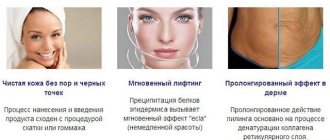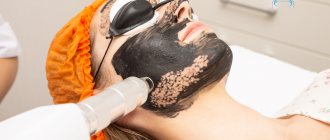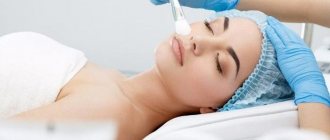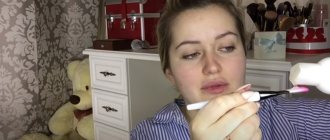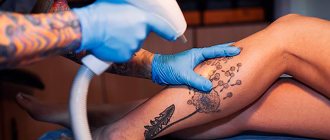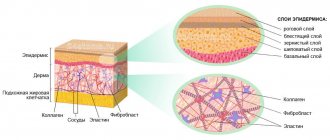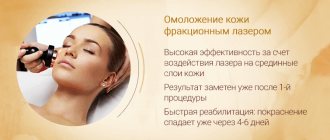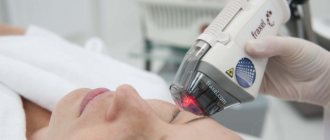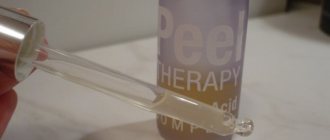Fractional laser peeling renews skin without complications
A safe alternative that we offer you at Platinental is fractional peeling Asclepion Dermablate (Germany). Asclepion is a true multifunctional laser complex, which is equipped in every reputable plastic surgery clinic in the world.
Non-traumatic Asclepion laser peels from 50 microns are used to get rid of superficial skin imperfections and the first signs of aging.
Fractional laser peeling Asclepion:
- eliminates wrinkles,
- reduces pore size,
- evens out skin texture,
- tightens and restores its elasticity,
- eliminates pigmentation,
- and due to the effect of more uniform light refraction, the skin after laser peeling looks radiant and healthy.
How does laser work on acne-affected skin?
Laser radiation is aimed at individual affected areas of the skin, while, which is very important, it does not affect healthy tissue. At the same time, laser exposure reduces the activity of the sebaceous glands, promotes rapid healing of wounds, improves blood supply, and normalizes the processes of sebum production.
When treating patients with acne, doctors set three goals:
- achieve complete clinical cure (disappearance of all acne elements);
- prevent the development of post-acne scars (acne scars on the face) or improve the condition of existing scars;
- develop an individual set of preventive measures to prevent the development of acne in the future.
In the fight against inflammatory elements, a non-ablative technique is used to influence the bacterial flora of acne lesions, based on the effect of homogeneous photothermolysis provided by a long-pulse Nd:YAG laser. Laser parameters:
- pulse duration - 50–100–200 ms;
- energy density - 15–50 J/cm2;
- working spot diameter is 4–6 mm.
The technique is used to treat all forms of acne at any stage of development of the elements. It is based on the absorption of a wavelength of 1064 nm by the protein shell of microflora with the appearance of the effect of bacteriolysis; It is used both independently and in complex acne therapy. During the procedure, a sighting arm is used to work on single elements and an S-II scanner is used to work over the entire affected area in severe cases. The radiation of a long-pulse Nd:YAG laser is aimed at sterilizing acne lesions. It must be remembered that laser treatment is not compatible with the use of drugs that increase photosensitivity.
The choice of laser depends primarily on the stage of the disease:
- Stage 1 - it is enough to use an Nd:YAG laser, 1-2 procedures per week, a course of 8-10 (number of passes - 1-2);
- Stage 2 - in the first place is the use of Nd:YAG laser, but the tactics change: 3-4 procedures daily (number of passes 1-2), then a break in treatment for 3-5 days, then a repeat course of 8-12 procedures , and after 2–4 weeks the use of an erbium or CO2 laser is added;
- Stage 3 - first, long-term treatment of papulopustular rashes with a course of 10–12 procedures: daily sessions or at intervals of 3–7 days, which is determined by the doctor as the patient’s skin recovers (number of passes 3–4), and then skin resurfacing.
From the above, it becomes clear that in the treatment of acne, regardless of the type of laser used, the first stage is the fight against inflammatory elements and only then comes skin resurfacing. Men have thicker skin than women, which is why they use higher laser parameters.
Laser resurfacing is based on the use of a laser beam, which penetrates the surface layers of the skin (1–20 microns) and ensures the evaporation of cells. The old layers of the epidermis are eliminated, the skin is regenerated and completely renewed: collagen fibers exposed to laser stimulation stimulate the appearance of new fibroblast cells, which, in turn, synthesize new fibers.
The following types of lasers are used to treat acne: neodymium, erbium, carbon dioxide (CO2), and fractional. The radiation energy of an erbium laser is concentrated in a thin layer of skin at a depth of about 1 micron, while the radiation of a carbon dioxide laser penetrates deeper - up to 20 microns. The main effect in the first case is the evaporation of cells, in the second it additionally causes tissue coagulation. Considering such differences in action, carbon dioxide laser is used if they want to achieve the maximum effect of skin renewal and smoothing of its relief, which, however, is associated with a higher risk of complications. The erbium laser operates more cautiously.
In turn, fractional lasers heat the skin in the treatment area not over the entire area, but in microfractions, forming areas of coagulation necrosis with a diameter of about 0.2 mm and a depth of up to 1.5 mm. Heating and coagulation in the epidermis occurs in the lower layers; the stratum corneum of the epidermis is practically not damaged. “Columns” of coagulative necrosis are surrounded by a zone of burn shock. In the latter, within 1–3 hours after laser exposure, heat shock proteins, growth factors, and interleukins are released, which trigger proliferation processes in the epidermis and dermis, activate intra- and extracellular proteolysis and attract immune cells, primarily macrophages, to the damaged area. Due to the migration and division of epidermal stem cells, the basal layer in the affected area is completely restored after 24 hours.
Do not forget that the use of a carbon dioxide laser requires anesthesia; when using an erbium and fractional laser, only superficial anesthesia is sufficient, but procedures with a neodymium laser are practically painless and do not require any anesthesia. The choice of type of laser procedure depends on the course of acne in a particular patient. The amount of intervention required and the duration of the recovery period are taken into account.
Laser resurfacing of post-acne scars. Performed by dermatocosmetologist Elena Vlasova.
5TH DAY AFTER ONE PROCEDURE
Before resurfacing, severe post-acne, inflammatory elements, enlarged pores, pigmentation, dull complexion. After the first resurfacing, the complexion changed, the pores narrowed, the skin texture became smoother, and pigmentation decreased. Inflammation also became noticeably less. General fresh, rested appearance. Immediately after the procedure, redness of the skin and minor pain were observed. Rehabilitation took 4 days. After the first grinding, minor tasks were solved. The main goal is smooth skin without the consequences of post-acne, which will be solved gradually with the following procedures. After the second polishing we plan to even out the skin texture and reduce pigmentation.How is the procedure done?
Cleaning does not require special preparation; it can be performed at any time convenient for the patient. At the first stage, you need to cleanse the skin of makeup, then it is treated with an antiseptic composition. The patient puts on special protective glasses (this is necessary to prevent the laser from affecting the eyes), after which laser treatment of the skin begins - gradually, from zone to zone. A special carbon gel helps to increase the effectiveness of the procedure (it is applied to a prepared, cleansed face).
Laser exposure causes some discomfort, and some patients require the use of a special numbing cream. The length of the beam that the laser device spreads is adjustable; if there is obvious pain during the procedure, it should be reduced.
After cleansing is completed, soothing and moisturizing compounds are applied to the skin.
Advantages and disadvantages
Speaking about the advantages of hardware cleansing procedures, you can give many arguments in favor. We list only a few of them. As for the shortcomings, they are very conditional. Because nothing compares in effectiveness to manipulations carried out in a cosmetologist’s office. Only a doctor can choose a truly working program of cleansing, care, and rejuvenation. Taking into account the type and condition of your skin, the specialist will draw up an individual transformation plan. You will see results after your first visit to the clinic!
| pros | Minuses |
| + minimal trauma; | - higher cost compared to home care products;; |
| + comprehensive cleansing that cannot be achieved at home or by manually cleansing the face; | — some types of hardware peeling have strict contraindications; |
| + many options – each patient will find a suitable type of hardware cleaning; | - the need to regularly carry out procedures to maintain the effect. |
| + all-season; | |
| + ability to work with different skin types; | |
| + with regular visits to procedures, a long-lasting cosmetic effect is achieved |
Operating principle of fractional photothermolysis
Fractional photothermolysis is based on the principle of zonal laser exposure. Imagine a beam divided into many microbeams - this is a fractional laser beam. Its advantage is that it affects the skin not with a continuous stream of light, but with an intermittent micromesh. Therefore, burns after a laser are a large number of microdots that alternate with unaffected skin. Epidermal cells and collagen fibers from undamaged skin migrate to the burn site, thereby speeding up the recovery process.
The laser damages the skin in a good way; this method forces the cells of the middle layers of the skin to actively produce collagen for restoration. And a large amount of collagen fills wrinkles and makes the tissue firmer and more elastic. Laser resurfacing evens out the relief and tone of the facial skin.
Are there any contraindications
Not everyone is allowed the procedure. Contraindications to the use of an erbium laser are:
- Keloid scars;
- Damage, inflammation on the skin;
- Herpes;
- Poor skin ability to recover;
- Erythema;
- Pregnancy and breastfeeding;
- Chronic diseases in the acute stage.
The restrictions also apply to those taking medications with retinoids. Erbium laser resurfacing can be carried out six months after completing a course of taking such medications.
Sagging and dehydrated skin should first be prepared, and then after 3 months all defects should be polished.
Pigmentation remover
Another area of use of athermal laser is the removal of skin pigmentation. The laser beam acts selectively - only on those cells in which there is an excess of melanin. Normal cells are “invisible” to the beam, so it does not affect them.
During the procedure, the following are removed:
- Freckles;
- Solar pigmentation;
- Age-related pigmentation.
The treated surface soon after the procedure darkens and begins to peel off. After 5-10 days, the pigmentation disappears. As a rule, the procedure must be repeated. On average, 2-4 procedures are required to achieve clear skin.
Positive reviews about laser pigmentation removal confirm its effectiveness.
What does sanding help with?
Polishing corrects age-related changes in the skin, normalizes oiliness and helps eliminate post-inflammatory processes. The laser beam promotes the production of collagen and elastin. At the same time, small wrinkles and traces of ultraviolet exposure are removed.
Erbium laser resurfacing also helps:
- Narrow pores, make the skin elastic and less loose;
- Remove scars and stretch marks;
- Get rid of acne scars.
After this treatment, the skin rejuvenates, becomes healthy, and acquires a silky and even tone.
